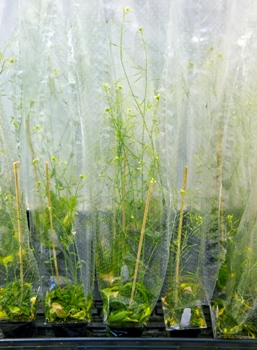Jun 24 2014
Researchers at the U.S. Department of Energy (DOE)’s Joint BioEnergy Institute (JBEI) have unveiled the first glycosyltransferase clone collection specifically targeted for the study of the biosynthesis of plant cell walls.
 The JBEI GT Collection, the first glycosyltransferase clone collection specifically targeted for the study of plant cell wall biosynthesis, features GT clones of rice (shown here) and Arabidopsis plants. (Photo by Roy Kaltschmidt)
The JBEI GT Collection, the first glycosyltransferase clone collection specifically targeted for the study of plant cell wall biosynthesis, features GT clones of rice (shown here) and Arabidopsis plants. (Photo by Roy Kaltschmidt)
The idea behind what is being called “the JBEI GT Collection” is to provide a functional genomic resource for researchers seeking to extract the sugars in plant biomass and synthesize them into clean, green and renewable transportation fuels.
Glycosyltransferases (GTs) are enzymes that catalyze the connection of simple monosaccharide sugars into the complex polysaccharide sugars that are essential to a wide range of plant cell structures and processes. While it is known that plants have evolved large families of GTs, the chemical nature of these enzymes is such that the specific functions of most GTs remain largely unknown. This is a major drawback for bioenergy research where the goal is to modify plant biomass for maximum fuel yields.
To address this problem, especially as it pertains to cell wall biosynthesis, a large team of JBEI researchers, led by Joshua Heazlewood, director of JBEI’s Plant Systems Biology program, has cloned and verified a clone library consisting of 403 Arabidopsis GTs and 96 rice GTs. In plant biology, Arabidopsis is the reference plant for species like poplar, and rice the reference plant for grasses.
“Using the unique infrastructure and resources at JBEI, we have provided a collection of high quality GT clones, all of which have been verified by sequencing and are available in easy to use cassettes,” Heazelwood says. “We’re making this entire collection available to the plant research community and expect it to drive our basic understanding of GTs and enable the manipulation of cell walls.”
In addition to the clones for Arabidopsis and rice GTs, Heazlewood and his collaborators at JBEI also created a set of highly efficient particle bombardment plasmids – pBullets – which are plasmids shot into a cell to mark the location of targeted proteins. The JBEI pBullets are constructed with markers for the plant endomembrane system, the collection of membranes that separates a cell’s functional and structural compartments.
“Our pBullet vector series is custom designed for efficient bombardment,” Heazlewood says. “Researchers generally use large unwieldy plasmids that perform badly when it comes to localizing proteins.”
While the 403 Arabidopsis clones represent approximately 88-percent of the defined Arabidopsis GTs, the 96 rice clones represent only 15-percent of the defined rice GTs. JBEI researchers are now working to expand this. Both the JBEI GT Collection and pBullet vector series are available to the research community through various outlets.